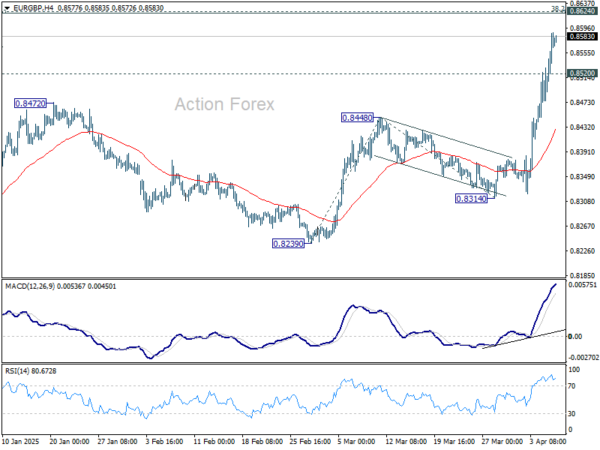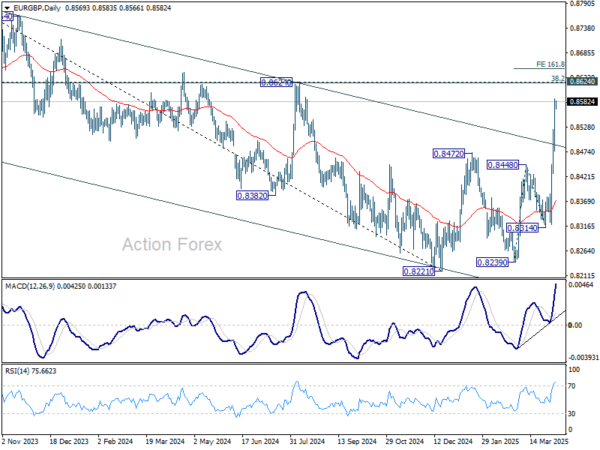Markets Stabilize As Tariff War Enters Complex Negotiation Battles

Global market sentiment is showing tentative signs of stabilization. The tone improved slightly as US Treasury Secretary Scott Bessent signaled that for countries choosing not to retaliate, the US has already reached a “maximum tariff level,” which could gradually be rolled back. However, this was far from a green light for relief, as the broader picture of US trade strategy continues to unfold.
What’s becoming increasingly clear is that the US administration’s goals extend well beyond mere tariff reductions. Washington is also targeting non-tariff trade barriers such as government subsidies, currency policies, and broader regulatory practices. This shift complicates trade negotiations significantly, especially as each partner country faces vastly different economic and political constraints. The complexity will likely prolong the path to resolution.
Different countries are responding in markedly different ways. China has chosen confrontation, swiftly imposing its own 34% retaliatory tariffs and now faces a threat from US President Donald Trump of an additional 50% levy if Beijing doesn’t back down in the coming days. China’s commerce ministry rebuked the threat, accusing the US of “blackmail,” signaling that neither side is ready to concede. The world’s two largest economies appear headed for a more protracted and damaging showdown.
In contrast, the EU is walking a more calibrated line. While the European Commission did announce a narrow set of retaliatory tariffs on Monday evening—targeting the original US steel and aluminum duties—it has held off for now on countering the broader reciprocal measures. EU trade chief Maros Sefcovic reiterated the bloc’s openness to negotiations, proposing a “zero-for-zero” approach for industrial goods. Still, he warned that the EU would not “wait endlessly,” and a broader retaliatory package is expected by the end of April.
The situation with Japan is fluid too. While Tokyo has so far avoided direct retaliation, it’s clear that the US expects major concessions. Treasury Secretary Bessent confirmed that upcoming talks with Japan will cover not only tariffs but also non-tariff trade barriers, government subsidies, and even currency policy. How Japan responds in this multi-dimensional negotiation will be critical, especially as the minority government faces domestic political pressure and a fragile recovery.
Amidst this backdrop, traders are being cautioned to remain vigilant amid rising market noise and disinformation. False rumors—such as claims the US might delay its tariffs by 90 days or that Fed had called an emergency meeting—circulated widely but were promptly debunked.
In the currency markets, Swiss Franc is currently the strongest one for the week, followed by Loonie, and then Aussie. Sterling is the worst performer, followed by Yen and then Kiwi. Dollar and Euro are positioning in the middle.
In Asia, at the time of writing, Nikkei is up 5.51%. Hong Kong HSI is up 1.58%. China Shanghai SSE is up 0.91%. Singapore Strait Times is down -1.54%. Japan 10-year JGB yield is up 0.0119 at 1.234. Overnight, DOW fell -0.91%. S&P 500 fell -0.23%. NASDAQ rose 0.10%. 10-year yield rose 0.170 to 4.155.
Fed’s Kugler: Anchoring inflation expectations must remain top priority
Fed Governor Adriana Kugler emphasized the importance of keeping inflation expectations well anchored in comments delivered to a Harvard economics class.
She reaffirmed the Fed’s commitment to the 2% inflation target and stressed “It should be a priority to make sure that inflation doesn’t move up”.
Kugler also noted that economic activity in the first quarter may have been stronger than previously anticipated, driven by consumer front-loading ahead of expected tariff hikes.
While the full extent of tariff-related cost pass-through is yet to be seen, she acknowledged the financial strain such developments could place on households. That, she argued, is “exactly why we think we need to keep focus on that.”
Fed’s Goolsbee: Must rely on hard data, no simple playbook for stagflation risks
Chicago Fed President Austan Goolsbee expressed concern that escalating trade tensions—through tariffs, retaliations, and potential counter-retaliations—could recreate the turbulent economic conditions of 2021–2022 when inflation was “raging out of control.”
In an interview with CNN, he warned that if the tariff threats materialize to their full extent, especially if met with proportionate responses, the US economy risks slipping back into a period of high inflation and stagnating growth.
However, Goolsbee also acknowledged that the situation remains fluid. He noted that negotiations could yet defuse the tension, especially if they result in new trade agreements. Referring to Treasury Secretary Scott Bessent’s optimism about a coming “golden age of trade.”
If stagflation begins to take hold, Goolsbee stressed, the Fed’s response would not be straightforward. The appropriate policy path would depend heavily on how growth and inflation evolve in the coming months.
“Our job is to look at the hard data,” he said, underlining that in a scenario where both growth weakens and prices surge, there’s no “generic answer” to guide monetary policy.
Aussie Westpac consumer sentiment slumps post-tariff shock; RBA seen tilting toward May rate cut
Australia’s Westpac Consumer Sentiment index plunged -6.0% in April, dropping from 95.9 to 90.1. The steep fall was notably skewed by the timing of the survey in relation to US announcement of reciprocal tariffs on April 2.
Respondents surveyed before the announcement showed only a modest dip in sentiment to 93.9. Those surveyed after reported a sharp drop of nearly 10% to 86.6. .
The sub-indices measuring sentiment towards the economy were particularly hard-hit, with the outlook for the next 12 months falling -5.7% to 90.5, and the 5-year outlook slipping back by -3.0%
With RBA set to meet on May 19-20, Westpac believes the weakening external backdrop, coupled with softer inflation, will push RBA to deliver another 25 bps rate cut. RBA is likely to become “much more focused on downside risks to growth than lingering questions about inflation”.
Australia NAB business confidence dips to -3 ahead of tariff impact
Australia’s NAB Business Confidence index dipped slightly from -2 to -3 in March, remaining firmly in negative territory. Business Conditions, however, edged up from 3 to 4, a modest improvement that still leaves them slightly below average overall.
Cost pressures remained broadly stable, with purchase costs rising 1.4% in quarterly equivalent terms and product price growth holding at 0.5%. Labour cost growth eased slightly.
NAB Chief Economist Sally Auld noted that conditions continue to vary across industries, with the services sector faring best while manufacturing and retail remain under pressure.
Importantly, this data predates the escalation of the global trade dispute, particularly the reciprocal tariff measures announced in early April. As Auld cautioned, these developments could “flow through to forward looking measures in the next survey.”
EUR/GBP Daily Outlook
Daily Pivots: (S1) 0.8491; (P) 0.8541; (R1) 0.8621; More…
Intraday bias in EUR/GBP remains on the upside for the moment. Current rise from 0.8221 is in progress for 0.8624 key cluster resistance next. Decisive break there will be an important indication of larger bullish trend reversal. On the downside, below 0.8520 minor support will turn intraday bias neutral and bring consolidations first.
In the bigger picture, the break of medium term channel resistance is a bullish signal. Down trend from 0.9267 (2022 high) could have completed at 0.8221, just ahead of 0.9201 key support (2022 low). Firm break of 0.8624 cluster resistance (38.2% retracement of 0.9267 to 0.8221 at 0.8621) will confirm this bullish case and target 61.8% retracement at 0.8867 next. Nevertheless, rejection by 0.8624 will keep medium term outlook neutral at best.
The Penny Drops: Understanding The Complex World Of Small Stock Machinations
Micro-cap stocks, often overlooked by mainstream investors, have recently garnered significant attention due to rising c... Read more
Current Economic Indicators And Consumer Behavior
Consumer spending is a crucial driver of economic growth, accounting for a significant portion of the US GDP. Recently, ... Read more
Skepticism Surrounds Trump's Dollar Devaluation Proposal
Investors and analysts remain skeptical of former President Trump's dollar devaluation plan, citing tax cuts and tariffs... Read more
Financial Markets In Flux After Biden's Exit From Presidential Race
Re-evaluation of ‘Trump trades’ leads to market volatility and strategic shifts.The unexpected withdrawal of Joe Bid... Read more
British Pound Poised For Continued Gains As Wall Street Banks Increase Bets
The British pound is poised for continued gains, with Wall Street banks increasing their bets on sterling's strength. Th... Read more
China's PBoC Cuts Short-Term Rates To Stimulate Economy
In a move to support economic growth, the People's Bank of China (PBoC) has cut its main short-term policy rate for the ... Read more



